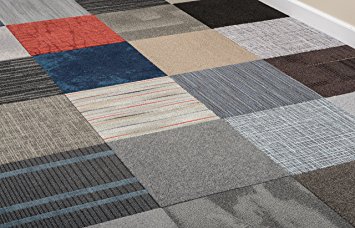Carpet tiles
Carpet tiles, also known as carpet squares, are a type of flooring which can be used as an alternative to the more common rolled carpet. They are formed from an upper layer of pile attached to a backing and are produced in a variety of sizes, materials, fibres, patterns and colours. Carpet tiles are often used in commercial and public buildings such as airports, offices, schools, libraries, and so on.
For the different types of carpet fibers, see Types of carpet.
Carpet tiles are manufactured in both non-adhesive (require gluing) and adhesive (peel-and-stick) styles.
When choosing tiles, it is important to consider the overall design scheme and the requirements of the finished floor, as well as the size and durability of the tiles required.
Some of the benefits of using carpet tiles include:
- They can be easier to install than rolled carpet.
- They can be installed over many floor types, including timber and concrete.
- Individual tiles can be removed and replaced for cleaning or if they get damaged.
- Creative patterned designs can be achieved.
- Many tiles are manufactured with good stain resistant properties.
Some of the drawbacks of using carpet tiles include:
- The seams of the tiles are more visible than rolled carpet and so require careful installation to avoid an uneven appearance.
- They can have a 'corporate' or 'municipal' feel.
- They can become unstuck, and curling or lifting at edges can create a trip hazard.
- They can be more difficult to remove than rolled carpet, which can be easily lifted.
- They can make access to under-floor services more difficult.
- They are generally not suitable for areas where they may be exposed to moisture.
- They can be more expensive than rolled carpet.
[edit] Related articles on Designing Buildings Wiki
Featured articles and news
Moisture, fire safety and emerging trends in living walls
How wet is your wall?
Current policy explained and newly published consultation by the UK and Welsh Governments.
British architecture 1919–39. Book review.
Conservation of listed prefabs in Moseley.
Energy industry calls for urgent reform.
Heritage staff wellbeing at work survey.
A five minute introduction.
50th Golden anniversary ECA Edmundson apprentice award
Showcasing the very best electrotechnical and engineering services for half a century.
Welsh government consults on HRBs and reg changes
Seeking feedback on a new regulatory regime and a broad range of issues.
CIOB Client Guide (2nd edition) March 2025
Free download covering statutory dutyholder roles under the Building Safety Act and much more.
AI and automation in 3D modelling and spatial design
Can almost half of design development tasks be automated?
Minister quizzed, as responsibility transfers to MHCLG and BSR publishes new building control guidance.
UK environmental regulations reform 2025
Amid wider new approaches to ensure regulators and regulation support growth.
The maintenance challenge of tenements.
BSRIA Statutory Compliance Inspection Checklist
BG80/2025 now significantly updated to include requirements related to important changes in legislation.
Shortlist for the 2025 Roofscape Design Awards
Talent and innovation showcase announcement from the trussed rafter industry.























